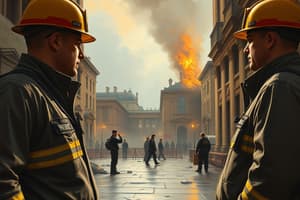Podcast
Questions and Answers
What is the primary purpose of examining a building's structure and surrounding circumstances?
What is the primary purpose of examining a building's structure and surrounding circumstances?
- To determine the historical significance of the building
- To assess the architectural style of the building
- To prevent being caught in a potential collapse (correct)
- To enhance the aesthetic appeal of the structure
Which of the following is NOT considered an indication of a building losing its structural integrity?
Which of the following is NOT considered an indication of a building losing its structural integrity?
- Noises indicating movement
- Unusual settling conditions
- Visible cracks in walls
- Increased foot traffic around the building (correct)
What type of conditions might signal that a building is struggling against gravity?
What type of conditions might signal that a building is struggling against gravity?
- Changes in the building's color
- Physical indicators like cracks or noises (correct)
- Sounds from nearby wildlife
- Unusual air pressure changes
What should be done if cracks in walls begin to expand during an operation?
What should be done if cracks in walls begin to expand during an operation?
What signifies that there may be a more serious issue if water runoff is just a trickle from the front door?
What signifies that there may be a more serious issue if water runoff is just a trickle from the front door?
Which statement about cracks or bulges in walls is correct?
Which statement about cracks or bulges in walls is correct?
What should be considered a prime indicator of potential floor collapse?
What should be considered a prime indicator of potential floor collapse?
When should withdrawal of forces be considered during firefighting operations?
When should withdrawal of forces be considered during firefighting operations?
What does the 20-minute time frame refer to when assessing fire situations?
What does the 20-minute time frame refer to when assessing fire situations?
What is indicated by the presence of certain businesses occupying a building?
What is indicated by the presence of certain businesses occupying a building?
Which construction type poses a more significant risk than truss construction in the context of structural collapse?
Which construction type poses a more significant risk than truss construction in the context of structural collapse?
What should trigger a careful examination for signs of possible collapse?
What should trigger a careful examination for signs of possible collapse?
What is a critical indication that safety may already be compromised during a fire incident?
What is a critical indication that safety may already be compromised during a fire incident?
Which of the following is NOT an indicator of potential collapse?
Which of the following is NOT an indicator of potential collapse?
Which factor can contribute to recognizing the danger level of a fire before a structural failure occurs?
Which factor can contribute to recognizing the danger level of a fire before a structural failure occurs?
What should be prioritized when recognizing fire hazards?
What should be prioritized when recognizing fire hazards?
What sound is most indicative of movement occurring in a wood building?
What sound is most indicative of movement occurring in a wood building?
What phenomenon might indicate that subtle movement is taking place within a structure?
What phenomenon might indicate that subtle movement is taking place within a structure?
What specific structural movement can cause distortion in door and window frames?
What specific structural movement can cause distortion in door and window frames?
What is the main benefit of an orderly withdrawal process during a collapse scenario?
What is the main benefit of an orderly withdrawal process during a collapse scenario?
Which method is appropriate for communicating an emergency evacuation to those without radios?
Which method is appropriate for communicating an emergency evacuation to those without radios?
What is a potential drawback of using audible warning devices during an emergency evacuation?
What is a potential drawback of using audible warning devices during an emergency evacuation?
What action should the Incident Commander take if a unit does not acknowledge the evacuation order?
What action should the Incident Commander take if a unit does not acknowledge the evacuation order?
In an emergency evacuation, what is the immediate action members are instructed to take?
In an emergency evacuation, what is the immediate action members are instructed to take?
What is an implication of water or smoke seeping through a solid brick wall?
What is an implication of water or smoke seeping through a solid brick wall?
Which observation might indicate that a roof is pulling away from the wall?
Which observation might indicate that a roof is pulling away from the wall?
How should one respond to a roof that is sagging or feeling abnormally soft?
How should one respond to a roof that is sagging or feeling abnormally soft?
Which condition can make sponginess in a roof potentially natural?
Which condition can make sponginess in a roof potentially natural?
What factors should be evaluated when assessing the condition of a spongy roof?
What factors should be evaluated when assessing the condition of a spongy roof?
Flashcards
Building collapse indicators
Building collapse indicators
Signs or observations that suggest a building is at risk of collapse. These include physical damage, unusual noises or conditions.
Heavy occupancy
Heavy occupancy
Certain businesses with heavy equipment or materials that can overload floors, potentially leading to collapse.
Truss construction risk
Truss construction risk
Structures with truss construction, such as supermarkets and bowling alleys, can be especially vulnerable, particularly in fire situations.
Lightweight materials risk
Lightweight materials risk
Signup and view all the flashcards
Overloaded floors
Overloaded floors
Signup and view all the flashcards
Long fire duration
Long fire duration
Signup and view all the flashcards
Timely evaluation
Timely evaluation
Signup and view all the flashcards
Water runoff issues
Water runoff issues
Signup and view all the flashcards
Cracks/Bulges
Cracks/Bulges
Signup and view all the flashcards
Roof indicators
Roof indicators
Signup and view all the flashcards
Movement indicators
Movement indicators
Signup and view all the flashcards
Noises as warnings
Noises as warnings
Signup and view all the flashcards
Plaster indicators
Plaster indicators
Signup and view all the flashcards
Collapse zones
Collapse zones
Signup and view all the flashcards
Emergency evacuation
Emergency evacuation
Signup and view all the flashcards
Post-evacuation procedures
Post-evacuation procedures
Signup and view all the flashcards
Audible signal cautions
Audible signal cautions
Signup and view all the flashcards
Study Notes
Collapse Indicators Overview
- Continuous examination of a building's structure is essential to avoid collapse.
- Indicators of potential collapse include physical signs like cracks, unusual noises, and observed conditions such as overly loaded floors.
Problematic Occupancy
- Certain businesses, such as plumbing supply stores and appliance dealerships, contribute to heavy floor loads.
- Occupancies with truss construction, such as supermarkets and bowling alleys, can be red flags.
- Recognizing potential threats from occupancy types is important for assessing collapse risk.
Construction Concerns
- Truss construction poses significant risks, particularly in fires.
- Lightweight materials, like particle board I-beams, require careful observation due to rapid deterioration under fire.
- The focus of individuals involved in construction often leans toward financial interests rather than firefighter safety.
Overloaded Floors
- Regular monitoring of floor loading is critical; heavy items can signal collapse risk.
Duration of Fire
- If heavy fire persists for more than 20 minutes without significant progress, withdrawal should be considered.
- Key indicators include reports from firefighting personnel regarding the fire's status.
Time Limits
- Evaluation timelines should depend on real-time observations, with the potential for quicker evacuation if conditions worsen.
Water Runoff
- Limited water flow from the building may indicate significant internal issues, necessitating investigation to prevent collapse.
Signs of Structural Weakness
- Cracks or Bulges: Indicate weakness; expanding cracks require timely evacuation.
- Roof Indicators:
- Water or smoke seeping through walls suggests internal pressure buildup.
- Roof separation from walls can indicate structural failure risk.
- Sagging roofs demand immediate evacuation as they are late-stage warning signs.
Movement Indicators
- Noticeable movement in floors, walls, or roofs often signifies imminent collapse.
Noises as Warning Signs
- Sounds like creaking, groaning, and deep rumbling can precede collapse events.
Plaster Indicators
- Sliding plaster or dust accumulation may signal structural movement, especially in wood-frame buildings.
Establishing Collapse Zones
- Upon identifying collapse potential, the Incident Commander (IC) must coordinate a systematic evacuation.
- Communication is vital; all units should confirm receipt of evacuation orders.
- Alternative signaling methods, like activating audible alarms, can aid in informing personnel of emergencies.
Emergency Evacuation Protocols
- In an emergency, members must prioritize safety over equipment, opting for rapid exit.
- Post-evacuation, personnel should regroup and prepare for roll call to ensure completeness of withdrawal.
Cautions for Audible Signals
- While audible warnings aid evacuation, they may drown out critical sounds indicating structural instability.
Studying That Suits You
Use AI to generate personalized quizzes and flashcards to suit your learning preferences.



